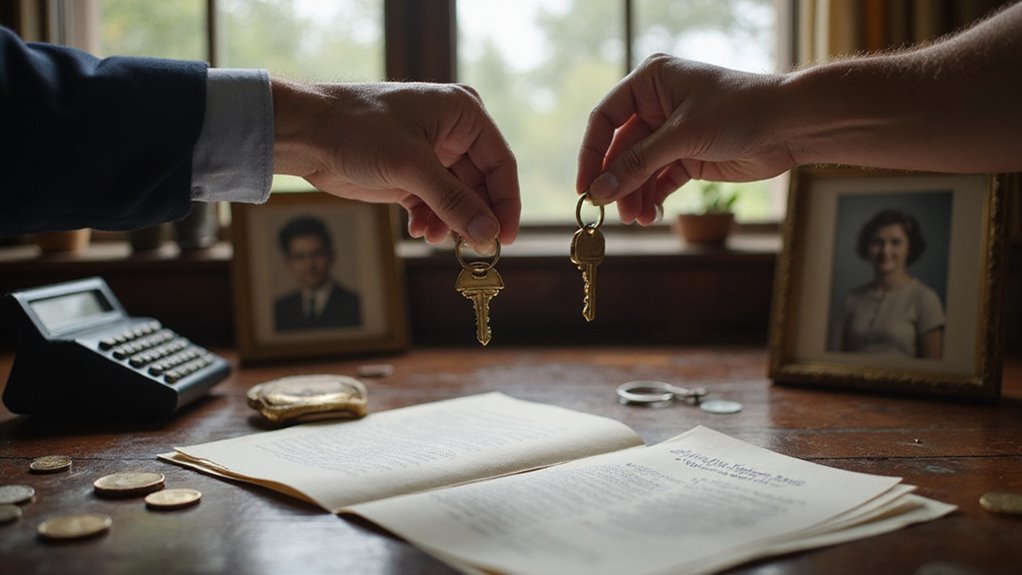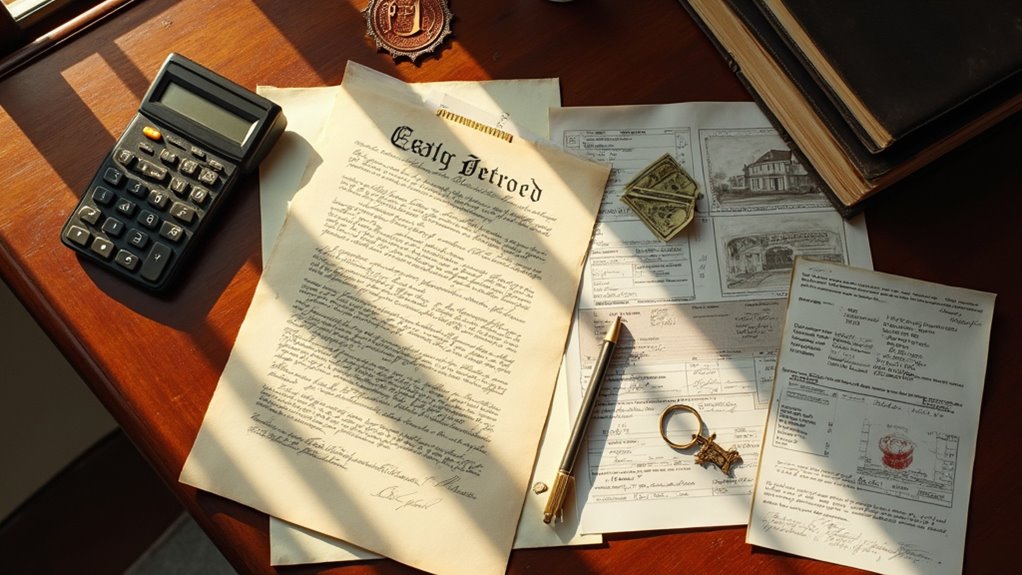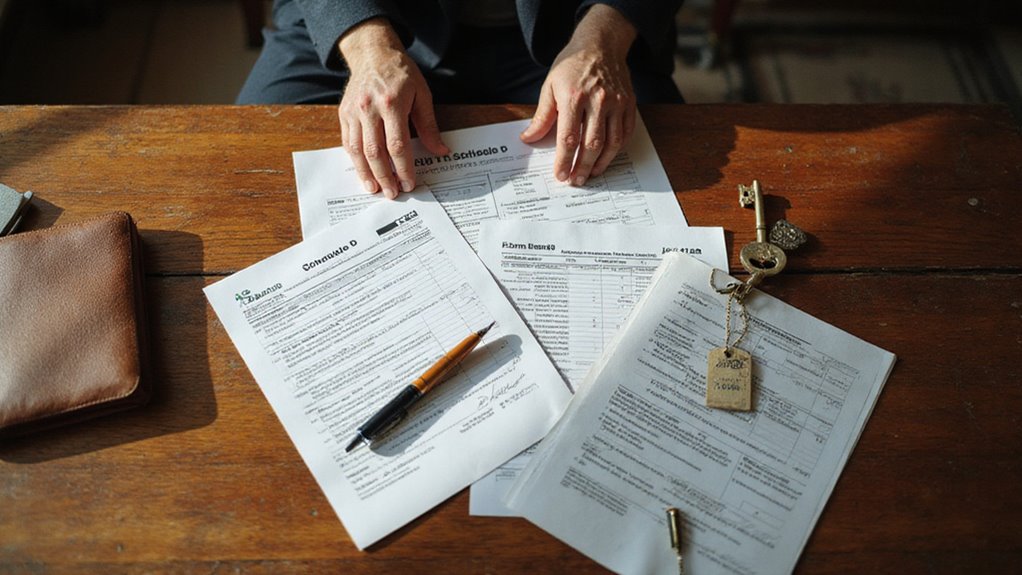Inheriting property brings both fortune and tax-related uncertainties for many Americans. Most beneficiaries worry about hefty tax bills when selling inherited properties, creating stress during an already emotional time. Fortunately, tax laws offer several provisions that can significantly reduce or eliminate your tax burden.
When you sell inherited property, you must pay taxes. However, the stepped-up basis rule reduces your liability by valuing the property at its fair market value upon inheritance. This means you only pay taxes on gains that occur after the inheritance date.
This blog explores everything about taxes on inherited property sales, exemptions, and money-saving strategies.
Key Takeaways
- Yes, inherited property is taxable when sold, but the stepped-up basis typically reduces or eliminates capital gains tax owed.
- The stepped-up basis resets property value to fair market value at death, eliminating tax on prior appreciation.
- Only gains from the inheritance date to sale date are taxable, making quick sales advantageous for minimizing taxes.
- Primary residence exclusion allows up to $250,000 or $500,000 (married) capital gains exemption under specific conditions.
- Long-term capital gains tax rates range from 0% to 20%, depending on income level and holding period.
Is Inherited Property Taxable When You Sell It?

Yes, inherited property is taxable when sold, but special rules make taxes lower than expected. The IRS applies a “step-up in basis” rule that values inherited property at its fair market value upon inheritance. Your tax applies only to gains that occur after you inherit the property.
A quick sale after inheritance can result in minimal or no capital gains tax. For example, if your parent’s house was worth $300,000 at inheritance and you sell it for $320,000, you’ll pay tax only on the $20,000 difference.
What Is Inherited Property and Basis Step-Up?
When you inherit property, you receive it at a “stepped-up basis,” which resets its value to the fair market value on the date of the original owner’s death. This step-up eliminates capital gains taxes on all appreciation that occurred during the deceased’s lifetime. Understanding how this basis adjustment works will help you calculate your actual tax liability if you decide to sell the inherited property.
Understanding Inherited Property
Inherited property consists of assets received after someone’s death. Any property passed down through a will, trust, or state law qualifies as inherited property. The tax law provides a stepped-up basis, which resets the property’s value to its worth on the death date. This adjustment helps reduce future tax obligations.
Capital gains taxes apply only to value increases that occur after inheritance. A lower tax burden means more money stays in your pocket. The stepped-up basis benefit makes selling inherited property financially advantageous. This simple tax structure allows families to handle inherited assets more effectively.
Explanation of Basis Step-Up
A basis step-up adjusts an inherited asset’s value to its market price at the owner’s death date. When someone inherits property, the tax basis becomes equal to the fair market value on the date of death. The new basis eliminates capital gains tax on previous appreciation. A property bought for $100,000 and worth $300,000 at death receives a new tax basis of $300,000. As a result, heirs save substantial money on future capital gains taxes. This tax benefit helps families preserve wealth and manage inherited assets more effectively.
How Basis Step-Up Affects Potential Taxes
Basis step-up reduces capital gains taxes for inherited property by adjusting the tax basis to current market value. The tax basis changes from the original purchase price to the property’s fair market value at death. A $150,000 house worth $400,000 at inheritance receives a new $400,000 tax basis. This adjustment eliminates taxes on appreciation during the original owner’s lifetime.
Furthermore, beneficiaries only pay capital gains tax on increases above the stepped-up basis. When heirs sell inherited property, they calculate gains using the stepped-up value instead of the original purchase price. As a result, tax liability decreases significantly for inherited assets.
How Does Capital Gains Tax Apply to Inherited Property?
Capital gains tax on inherited property applies only to value increases after the original owner’s death. The tax basis automatically adjusts to the property’s fair market value on the date of death. This “step-up” in basis eliminates taxes on gains that occurred during the deceased person’s ownership. Your tax obligation equals the difference between the sale price and this stepped-up basis. The property can be sold immediately without owing capital gains tax at the inherited value. Any later appreciation will be taxed at favorable long-term capital gains rates.
How to Calculate Taxes on Inherited Property Sales?

Calculating taxes on inherited property sales requires four essential steps to determine your actual tax liability. You’ll need to establish your stepped-up basis, compute any capital gains from the sale, identify exemptions that apply to your situation, and document property improvements that can reduce your taxable amount. These calculations directly impact how much you’ll owe to the IRS when you sell the inherited property.
Determining Your New Basis
Your new tax basis equals the fair market value of inherited property on the date of death. This simple rule helps reduce capital gains taxes on future sales. A qualified appraisal proves the property’s value for tax records.
The IRS allows a stepped-up basis to eliminate taxes on gains that occurred before inheritance. For married couples, community property receives a double step-up benefit. Your tax advisor can help document these important values.
Consider getting a professional property assessment right away. The accurate basis amount will make future tax calculations easier. Clear records protect your financial interests.
Calculating Capital Gains
Capital gains reflect the difference between an asset’s selling price and its purchase price. A simple formula determines capital gains: Sale Price – Original Cost Basis = Taxable Gain. Long-term capital gains tax rates range from 0% to 20% on profits from assets held over one year. The rate depends on your income level and filing status.
The cost basis adjusts when you inherit property. A stepped-up basis resets the property value to its fair market value on the date of death. This adjustment can reduce your future tax liability. Moreover, good records of improvements and expenses help lower taxable gains.
Identifying Qualifying Exemptions
Common tax exemptions for inherited property include stepped-up basis, primary residence exclusion, and selling expense deductions. The stepped-up basis rule eliminates capital gains tax when you sell property at its inherited market value. A primary residence exclusion offers up to $250,000 for single filers and $500,000 for married couples. This benefit applies after living in the inherited home for two years.
Moreover, you can reduce tax liability through deductible selling costs. These deductions include real estate agent fees, legal expenses, and post-inheritance property improvements.
Documenting Improvements to Reduce Tax Liability
Proper documentation of property improvements reduces your tax liability on inherited real estate sales. Save all receipts, invoices, and photos that show permanent upgrades to the property. Key documents must include detailed contractor bills, material costs, and proof of completed work.
A clear paper trail protects your financial interests during tax reporting. Major renovations like new roofs, HVAC systems, and structural repairs qualify as cost basis improvements. Regular maintenance expenses do not count toward basis adjustments. Create separate files for each improvement project with complete records. These organized documents help maximize tax benefits and protect more inheritance value.
What Are the Tax Exemptions for Inherited Property?
You can exclude up to $250,000 of capital gains ($500,000 for married couples) when selling an inherited property that qualifies as your primary residence under Section 121. If you’re a surviving spouse, you’ll benefit from special rules that may provide additional tax advantages, including the option to file jointly in the year of death. You should also consider whether the estate itself faces federal estate tax, which only applies to estates exceeding $13.61 million in 2024.
Primary Residence Exemption (Section 121)
The IRS offers significant tax savings when you sell your primary residence. Homeowners can exclude up to $250,000 in capital gains from taxes. Married couples who file jointly may exclude up to $500,000.
Several key requirements must be met to qualify for this benefit. You must live in the home as your primary residence for at least two years. The ownership period needs to fall within five years of the sale date.
Moreover, this exclusion applies once every two years. The tax break helps families keep more profits from their home sales. First-time sellers should consult a tax professional to ensure proper qualification.
Special Rules for Surviving Spouses
Surviving spouses can claim a $500,000 tax exclusion when selling an inherited home within two years of their partner’s death. The tax basis updates to the property’s fair market value on the date of death.
A spouse must meet key conditions to qualify. The property needs two years of primary residence use within the five years before the sale. After the two-year window expires, the exclusion drops to $250,000.
These rules protect more inheritance money through strategic timing. Smart planning allows families to preserve valuable assets during a difficult transition period.
Estate Tax Considerations
Estate tax applies specifically to inherited assets after someone’s death. Federal estate taxes only affect inheritances valued above $12.92 million in 2023. This high threshold means most people will not owe federal estate tax. Individual states can set their own estate tax limits, often between $1-5 million.
Tax planning strategies can reduce potential estate tax liability. A qualified tax professional can structure inheritances to maximize tax benefits. Moreover, proper documentation and valuation help ensure smooth asset transfers to beneficiaries.
Furthermore, certain assets receive special tax treatment. Life insurance proceeds and some retirement accounts may qualify for tax exemptions under specific conditions.
How to Minimize Taxes When Selling Inherited Property?
You can significantly reduce your tax burden when selling inherited property through strategic planning and proper timing. Four key approaches will help you keep more money from your sale: timing your sale strategically, making capital improvements before selling, offsetting gains with capital losses, and considering 1031 exchange options. Each method offers distinct advantages depending on your financial situation and long-term goals.
Timing Your Sale Strategically
The best time to sell inherited property is 6-12 months after receiving it. This window allows proper market assessment while minimizing carrying costs. The tax basis resets to fair market value on the date of death.
Smart sellers should evaluate seasonal trends in their local real estate market. Spring and early summer typically bring more buyers and better prices. Fall sales often attract serious buyers with year-end closing goals.
Property taxes and maintenance costs increase the longer you hold the property. A prompt sale reduces these ongoing expenses. Consider market conditions and your financial goals when choosing your timing.
Making Capital Improvements Before Selling
Smart capital improvements before selling can increase your property value and reduce tax liability. Save all receipts and documents for improvements to establish your adjusted tax basis. The IRS distinguishes between basic repairs and value-adding improvements. Focus on upgrades that attract potential buyers and enhance market appeal.
Popular improvements include kitchen remodels, bathroom updates, and energy-efficient windows. These changes often provide the best return on investment. Meanwhile, basic maintenance like painting or fixing leaks counts as repairs.
Before starting any major work, consult a tax advisor about qualifying improvements. A professional opinion ensures your investments meet tax guidelines and benefit your bottom line.
Offsetting Gains with Capital Losses
Capital losses can offset capital gains and reduce your tax liability. Smart investors balance gains and losses strategically. Taxpayers can deduct up to $3,000 in capital losses against ordinary income each year. Any unused losses roll forward to future tax years without expiration. The IRS allows you to match losses against gains dollar-for-dollar.
A clear strategy helps maximize benefits. Sell underperforming investments near year-end to capture losses. Then, match these losses with gains from inherited property or other investments. As a result, your overall tax burden decreases while preserving more wealth.
Considering 1031 Exchange Options
1031 exchanges allow property investors to defer capital gains taxes by reinvesting in similar properties. The IRS requires exchanged properties to be “like-kind” and used for business or investment purposes. A qualified intermediary must facilitate the exchange process.
Property owners need specific timing to complete exchanges successfully. Sellers have 45 days to identify replacement properties and 180 days to close the transaction. Moreover, the replacement property value must equal or exceed the sold property’s value. As a result, careful planning and professional guidance ensure proper execution of 1031 exchanges and maximum tax benefits.
What Tax Forms Will You Need to File?

To sell inherited property in Oklahoma, you must file three key tax forms: Form 8949 documents your capital asset sales and transactions with the IRS. Schedule D reports your total capital gains and losses on your federal return. Form 1099-S shows the proceeds from your real estate sale.
Additional paperwork requirements include proof of the property’s stepped-up value and Oklahoma state tax returns. Save all closing documents and appraisals to support your tax filings. Moreover, accurate record-keeping helps protect you during potential future audits.
Conclusion
Selling inherited property requires careful attention to tax implications and proper documentation of the sale process. The stepped-up basis can help reduce capital gains tax when you decide to sell. Professional guidance ensures compliance with tax regulations and maximizes your financial benefits.
At Shawn Buys Houses, we understand the complexities of selling inherited properties in Oklahoma City and surrounding areas. We help property owners navigate through tax documentation and required forms like Form 8949. We provide straightforward solutions for those looking to sell their inherited properties quickly and efficiently.
Our team serves multiple cities across Oklahoma State with professional house-buying services. We handle all paperwork and ensure proper documentation for tax purposes during the sale. We make selling your inherited property simple while helping you avoid unnecessary tax burdens.


